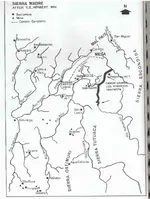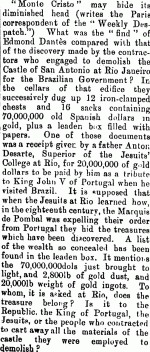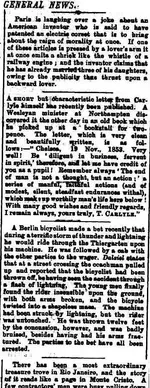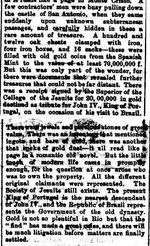Cactusjumper wrote
They leave it up to the reader to decide for themselves. Those who are so inclined, will conclude that it is the Tayopa Mine. How do you come to your written conclusions......"mission" and "Jesuits" from what is quoted above.
IMHO, it's just another unsupported story. Could be true, could be fiction.
I do
not come to those conclusions
from that single statement. How did you arrive at that - have I posted just too much words? As for "unsupported" for "mission" and "Jesuits" I will indulge you. This will be a VERY long post, and I beg your patience.
First, establishing that Teopari was in fact a MISSION and not just a visita,
Teopari A former pueblo of the Jova and seat of a Spanish mission founded in 1676 situated in к Sonora Mexico a few miles s E of the Opata village of Nacori Pop 369 in 1678 259 in 1730 Dolores was its visita The pueblo was abandoned between 1764 and 1800 owing to Apache depredations San Jose de Teopari de Ovas ZnpatA 167S in Doe Hist Мех 4th я HI 342 1857 San JCM Teopari Rivera 1730 quoted by Bancroft X Мех States i 514 1884 Tyopari Bandolier in Arch Inst Papers m 56 1890 iv 510 Iftrj
<from Handbook of the Indians Bulletin Volume 30, Part 2 By Smithsonian Institution. Bureau of American Ethnology, US Govt Printing Office, 1910, pp 730 >
Natera A former pueblo of the Jova in w Chihuahua Mexico near the mission of Teopari of which it was a visita prior to itd abandonment in 1748 The inhabitant moved to within half a league Arivechi and later settled in the of Ponida Batoimae Doc of 18th cent quoted by 1и Arch In Papers IV 511 1892
<ibid, pp 39>
Santa Maria de los Dolores Saint Mary of the Sorrows A former pueblo of the Jova with 180 inhabitants m 1730 situated in E Sonora Mexico near Rio Viejo a tributary of the Yaqui It formed a visita of the mission of Teopari prior to the abandonment of that pueblo on account of Apache depredations in the latter part of the 18th century Dolor Rivera 1730 quoted by Bancroft No Мех States I 614 1884 Loi Dolores Orozco y Berra Geog 345 1864 Santa Maria de los Dolores Rivera 1730 cited by Bandelier in Arch Inst Papers IV 510 1892
<ibid, pp 459>
The Mission of Natora was deserted in 1 748 by order of the Viceroy Count of Revillagigedo on account of its being incapable of administration from Teopari its head place because of the many mountains the dangerous passes and the long distance to the place where the natives belonging to the Jova nation located in the neighborhood of Aribechi They inhabit at present the town of Ponida from where they are attended Since then the town of Theopari with the Chamado ranch became part of the Saguaripa Mission the town of San Mateo having been depopulated that same year or a little before by an invasion of the Apaches San Mateo was visiting place of said Mission and the few natives of the Opata nation were sent to the head Mission as they could not resist such an enemy Rebeico of the Jovas visiting place of Matape was depopulated I do not know in what year because of
<note Apaches blamed for attack,
just as we find in the "legend" of Tayopa>
<from Records of the American Catholic Historical Society of Philadelphia, Volume 5 By American Catholic Historical Society of Philadelphia pp 227
I believe this passage directly relates to Don Jose's Tayopa
San Juan del Rio was in former times a little place inhabited by Opatas having been a visiting place of Texas and was twelve leagues further down the river from Opotu. The ruins of a small chapel are still to be seen there It was afterwards a rich Royal mining settlement The town called by the Opatas Toapora and which was depopulated in 1686 being powerless to withstand the attacks of the Apaches was a ranch of the Opatas situated three leagues further down the river and was good country
<ibid>
This is of course in opposition to J. Frank Dobie's claim that the record of history on Tayopa is "blank" for it is NOT blank.
That these Missions were closely associated with silver mines
vegetables through year In the neighborhood of this Mission there are a great many deserted silver mines the Apaches having made much havoc there and having put many to death One is San Juan del Rio twelve leagues North of Opotu another the Nori three leagues off in the same direction To the East Southwest and Southwest at a distance of four five seven or eight leagues and also to the Northwest at a distance of fifteen leagues the Indians have found evident signs of mines for the variety of color in the soil and stones as well as the flashes observed by night on the slope of some of the hills in the vicinity during the rainy season indicate the abundance of mineral ore but the extreme poverty of the inhabitants and the fear of the hostile Indians are obstacles in the way of working it The same signs are to be found in the environs of Guasabas but without being of any avail for the same reason and this is also true of two mines which yielded a great quantity of silver in years gone by when the Apaches used to come at longer intervals and in lesser numbers One was San Christobal five leagues West south west and the other San Patricio nearly the same distance West of Guasavas The first though hard had and will have a good vein whose metal is half silver It is a short distance from La Culebrilla and may be seen from the road According to a constantly repeated story among the natives there is likewise near La Cule brilla a vein of native silver which was for many years in the possession of an old man of Guasabas who upon going to get from his treasure what he needed used to take a chopping knife with which aided by a stone he cut the piece he thought large enough to supply his wants In order to hide the richness of his mine he was in the habit of melting the piece he had cut making an ingot of it as if it were common metal But neither from himself nor from a boy whom he was in the habit of taking with him as a guard with instructions to throw a stone if any one approached during the cutting of the silver has it been possible to learn the whereabouts of this vein The boy was ignorant of the locality of the vein for the old man was careful to place him where he could not see anything On the slope of the mountain which rises in the East in front of and in sight of the town they say there is another such vein of silver as is supposed known to an Indian who died in 1760 but as there is a tradition among the Indians that any one revealing the whereabouts of a mine soon dies they will not show one to a Spaniard for any price no matter how great the advantages offered them It is even of no use to tell them that the Missionary Father gives his pledge for the fulfilment of the promises made them and asserts that far from having their life shortened by revealing the secret God Almighty will prolong it should they have the courage to do away with such superstitions more fit for old women than for brave and wise men
Besides the productions mentioned we find in the vicinity of this Mission abundance of alum chalk and two springs of hot water one half a league to the North and the other one and a half leagues West of Guasavas In Opotu there is
<ibid>
Sound familiar? Now just a bit on the Jovas of Teopari;
The Opatas Eudebes and Jovas
The Opatas and some of the Eudebes though in a limited degree are in comparison to the other Indians as the people of the towns are in comparison to the country people for although they do not cease to be Indians yet in the end reason prevails with them among all of these they are the best Christians they are the most loyal vassals of our Lord the King never having rebelled against him or his ministers They are the most inclined to work to till their lands and to raise cattle they are the truest and bravest in war and many times have shown their courage both by aiding the Royal troops and on their own account in various campaigns at the expense of the Missions
What has been said of the Opatas may be more or less applied to the Eudebes with the only difference that the latter are still more attached to their ancient customs and usages The Jovas are ruder and more awkward especially the greater portion of their nation who are unwilling to live in villages barring those of Ponida Teopari and Mochopa They like to live in the ravines of the mountains where they were born and notwithstanding the good works done to them the kind treatment the conveniences and comforts offered them in order to retain them in the villages when they have been induced to come to them such is their obstinacy that they oppose everything just as it happened in the case of the present Missionary Father of the Bacadequatzi Mission of the Satechi ranches and those of the banks of the rivers Mulatos and Arcos who live on roots herbs and wild fruits planting nothing but a few stalks of corn and a few squashes in those places where they can be raised among the ravines formed by those rivers in the mountains
<ibid>
That these Missions are Jesuit,
Next to this is the Mission of Saguaripa four leagues North in twenty nine degress four minutes latitude and two hundred and sixty six degrees fifty minutes longitude of the one just mentioned The Missionary is Father Thomas Perez His visiting town Tespari is eighteen leagues to the East with some deviation towards the North These towns belong to the nation of Jova as does also the ranche of San Cayetano de Chamada seven leagues distant and the ranch of Chipafora eight leagues from the head Mission
<ibid>
I put TESPARI in bold because it is a typographical error - it is Teopari unmistakably by its description.
Sahuaripa is the next main mission, lying four leagues north of Arivechi at 29 degrees, 4 minutes latitude and 266 degrees, 54 minutes longitude. It is administered by Father Tomás Pérez [de la Busta] and has Teópari as a dependent mission. Sahuaripa also embraces the ranches of [San Cayetano de] Chamada [Chamata on Nentvig's map] seven leagues beyond Teópari and [San Juan de Dios de] Chipafora eight leagues north-northeast of Sahuaripa itself as well as the village of Santo Tomás just south to which the inhabitants of Chamada had been moved. Its parishioners belong to the Jova nation.
<Rudo Ensayo, Nentvig>
If you still have doubts look up Father Tomás Pérez de la Busta, S.J.
Further documentary evidence that Teopari had MINES
Les principaux placers et mines connus sont liasse
Sonora Placers de Totaiqui, de Calabazos, de Santo Domingo, los Placeres, Cañada del Oro, Bamachi, Bavispe, Lampazos, Palos blancos, San Antonio de las Huertas, Cajón de Guacomea, La Candelaria, La Jo joba, San Francisco Javier de Caloci, Chiltepín, Chinoverachi, Cañada de los Apaches, San José de Teopari Mesa de Guadalupe, Capulín, Mulatos, La Cieneguilla, Las Palomas, San Perfecto, El Senio, Quitovac, San Antonio et Sonoyta
<from LES ETATS UNIS MEXICAINS Leurs Resources Naturalles by R. De Zayes Enriquez MEXICO IMPRIMERIE DU MINISTÈR de FOMENTO Rue an Audres 5 1899 pp40>
Yes this is in French, but I am pointing out the NAME and the terms PLACER and MINES, so if you need more translation than this it will be easy for you.
This should establish that there WAS a Mission at Teopari, which was later a visita, that it was under Jesuit rectorship, that it has mines
In the same source mentioned earlier (Catholic records) , we find yet another "curious" passage, where the Missionary Father is complaining about runaway Indios whom were literally running away from the Missions to go work for the "evil" Spaniards in mines;
This love of idleness keeps them poor and needy so that the ministering priest has to provide them during most of the year with victuals and clothing if he wishes them to attend the instructions in their villages and not rove about among the placer mines of gold and the mining settlements where in a short time they forget the teachings and the Christianity which for many years and w1th indescribable labor has been imparted to them and learn in a few days vices of which they had no knowledge in their villages
This is the reason why some of the inhabitants of different villages and I speak of what I know with absolute certainty live with women clandestinely serving the Spaniards on distant ranches some ten some four some three years without the Missionary Father being able to trace their lurking places by the most careful search Even if by some means he succeeds in finding them out he lacks the power by which he could bring these stray sheep back to the fold and they pricked by the consciousness of wrong always on the <snip>
But I think I can give some light that will clear up the difficulty without much trouble by saying that in the first ranche or a mining settlement or Spanish town where the day laborers live separately the runaway Indians meet with teachers of such a character that in a couple of hours they are led into errors which corrupt them and cause the ruin of both body and soul and although having lived in their own villages and enjoyed the ownership of their property their liberty and their own persons subject only to the easy duties and ceremonies of the Christians for the love of a licentious life they stoop to slavery and condemn themselves to exile
It seems incredible that many of the relatives even husbands or wives when they have them should not know anything about the runaway Indian but it is a fact that no notice is given either to the Magistrate or the ministering father until they are missing from the town and then it 1s impossible even by offering mines of gold and promising secrecy as to who told to make anybody say what direction the fugitive took And here again we find a contradiction in their disposition the inviolability of secrecy m helping one another notwithstanding their inconstancy and fickleness
<ibid>
Offering mines of GOLD? How could a missionary offer this, if he had none?
Thank you for your patience to read through this very long post, I will close here.

Oroblanco




 ??
??
 The key words in what I did write were, "secret society".
The key words in what I did write were, "secret society".

